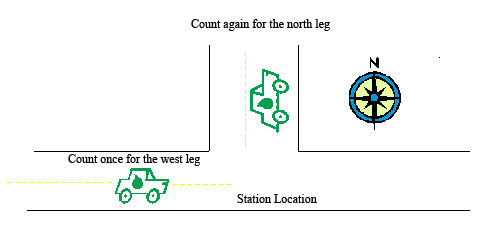Section 2: Form 1617A Blocks
Anchor: #i1002698General Information
Form 1617A has four blocks for entering data on two-to-four directions of traffic. A block, which contains cells, rows, and columns, is enclosed within a heavy, black line.
For each hour, a traffic counter must enter the following types of data into a block:
- Vehicle counts (classified as cars, trucks, buses, motorcycles, etc.)
- Weather conditions
- Traffic conditions
- Totals of vehicles by classifications
NOTE: If some of the cells within each block are not needed, leave them blank.
Anchor: #i1002738Counting Scenarios
There are three different counting scenarios that may be assigned for a traffic count, based on the number of legs or directions of traffic flow (north, east, etc.) You will use one of the four blocks on Form 1617A for each assigned traffic direction. If there are less than four directions of traffic for an assigned count, leave unused blocks blank.
Stations for Directional (Two-way) Counts. Stations located at a checkpoint (counting station) with no intersecting road will require two blocks on Form 1617A: one block for the traffic flowing toward the station and one for traffic flowing in the opposite direction. You must count each vehicle only once for the direction that it travels past the station.
Example. Assume a highway with four undivided lanes runs north and south from the counting station. A bus approaching the station from the south is counted once. A dump truck approaching from the north is counted once. There are no intersecting roads for the vehicles to turn onto and generate another count.
Stations for Three-way and Four-way Counts. Stations at intersections will use three or four blocks on Form 1617A. You must count each vehicle for each direction that it travels: one for the direction from which the vehicle approaches, and again for the direction to which it exits.
|
Example. Assume that there are three roads at the counting site: one to the north, one to the east, and one to the west. Figure 6-1 shows a vehicle approaching the station from the west and leaving the station to the north. The vehicle is counted twice: once in the block labeled west, and once in the block labeled north. |
|
Figure 6-1. Example of a counting scenario. |
NOTE: Be sure you assign the correct direction and code number in the correct block order on Form 1617A. See Chapter 5.
